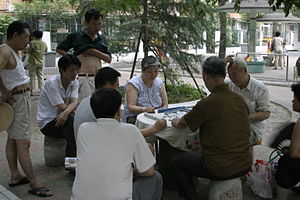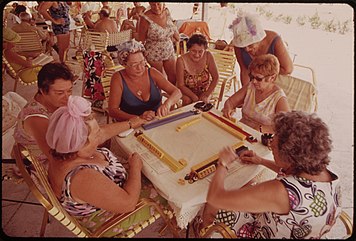|
Mahjong cultureMahjong (English pronunciation: /mɑːˈdʒɒŋ/ mah-JONG) culture refers to the various traditions, customs, beliefs, and practices surrounding the game of mahjong, a popular tile-based game originating in China.[1] It is played in other East Asian countries, such as Japan, Korea, and Taiwan,[2] as well as in other parts of the world. Mahjong has a long-spanning history that dates back more than a century. It has evolved over time to include different regional variations and cultures. The game has also become an important aspect of social life in many communities, often played at family gatherings, social events, and even in professional settings.  ChinaMahjong was created in 1846 by imperial servant Chen Yu-Men.[1] Within years, the game became extremely popular across China. There were local and regional variations, as there are today, but the game at its core was prevalent across the entire country. The game started to become heavily associated with gambling, smoking opium, and wasting time. As such, during the late Qing reforms, mahjong became considered a social issue. Mahjong started to become outlawed indirectly as gambling and smoking opium became criminalized. The ban was not very successful, however, at least until the Chinese cultural revolution. During the cultural revolution, mahjong was considered a part of “old culture” and that causes nearly all mahjong-related paraphernalia to be outlawed and or destroyed.[3] After the end of Mao's control, mahjong became popular again in the country as government and social reforms changed and became less restrictive. Culture and practicesMahjong, outside of being a game, is also widely considered to be a social activity that has been used to build relationships and create a sense of community. Being invited to play mahjong is seen as a form of kinship and acceptance in some cultures.[4] In China, mahjong is closely related to teahouse culture where players gather to play and socialize.[5] Mahjong is played almost anywhere a table is available or can be set up. This ranges from people's homes, streets, and sidewalks, or even workplaces. Indeed, playing mahjong can be considered a form of social gathering. Some consider mahjong to be primarily luck and only partly skill.[6] As such, divination and fortune play a large part in mahjong. There are many practices or rituals relating to the luck or fortune of the players in the game. Failing to properly execute them gives the player negative fortune, leading to the player's loss. For example, the seating arrangement of the players in mahjong is believed to bring either great luck or great misfortune, determining the outcome of the game. Seating arrangements must be determined randomly and given to the supernatural, so as to give everyone fair chances. Methods of determining seating arrangements vary across different cultures, but seating arrangements are almost always determined randomly.[7] Additionally, arranging the table at an angle, unaligned with the surrounding walls, is said to promote good fortune by aligning it with the mahjong ghosts.[8] Mahjong players also have many superstitious beliefs, some examples are:[9]
Additionally, expensive Mahjong sets can be seen as a status symbol and are a source of pride among families. Prevalence in other parts of the worldUnited StatesMahjong was brought to the United States in the 1920s by Joseph Park Babcock.[10] It was imported into the U.S. during a time when many Americans had held ancient China in high regard but held racial prejudice against contemporary Chinese. Mahjong was marketed as an exotic and mystical game played in ancient China and it quickly gained popularity.[11] Despite the anti-Chinese sentiment in the era, the game was played by many Americans, including Chinese Americans who saw the game as a way to connect with their Chinese heritage while also playing a trendy game.  Initially, the game was male-dominated, but over the course of the mahjong craze, it started to become more associated with women and femininity. The change is thought to be brought on by “the merging of American gendered ideas of Chinese culture with the strengthened association of women as archetypal consumers."[11] Another aspect of mahjong's popularity in the U.S. is its unique appeal to Jewish families, particularly women, even after the initial mahjong craze. Hoping to revitalize the game, a group of Jewish women from New York established the national Mah-Jongg League. By the mid-20th century, after World War II, Mahjong games became lodged in many Jewish-American families, offering a space for socializing, networking, and entertainment.[11] JapanMahjong was brought to Japan by soldier Saburo Hirayama in 1924; Hirayama opened a mahjong school and parlor to introduce the game to Japanese citizens.[12] Much like in America, the game had spread across the country and became widely popular. As of 2007, Japan has some twenty-two thousand mahjong parlors across the country, with at least five thousand of them inside Tokyo alone. Additionally, in Chiba, Japan, there is a mahjong museum that showcases the history of the game. Mahjong was the most popular game in Japan in 2010. Today, a considerable amount of mahjong in Japan is played digitally through the internet and software.[12] Hong KongIn Hong Kong:
However, Mahjong games also create problems. Addiction to Mahjong is a common type of problem gambling. Mahjong is also a favourite medium for bribery - the person giving the bribe will intentionally lose large sums of money to the person being bribed. PhilippinesIn the Philippines, games of mahjong are played graveside as a form of honoring the dead, specifically on All Souls’ Day.[11] See alsoReferences
Sources
|